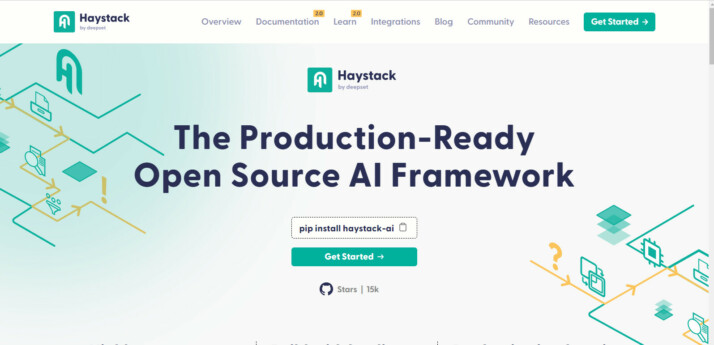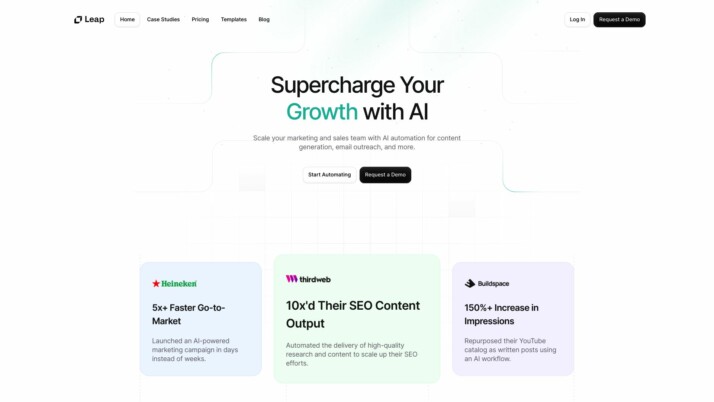Haystack vs. Leap AI: Comparing AI Development Platforms
AI development platforms Haystack vs. Leap AI offer contrasting approaches to harnessing the power of large language models and advanced AI capabilities. Haystack provides a robust framework for developers to build production-ready applications, while Leap AI democratizes AI development with its no-code platform. This comparison delves into the core features, strengths, and limitations of both platforms, exploring how they cater to different user needs and skill levels. We’ll examine their approaches to AI workflow creation, model integration, and deployment options, as well as their suitability for various business scenarios. By the end of this review, you’ll have a clear understanding of how Haystack and Leap AI stack up against each other and against SmythOS, our comprehensive AI development solution that combines power, flexibility, and ease of use.
Haystack Overview
Haystack empowers developers to build production-ready applications using Large Language Models (LLMs) and vector search. This open-source framework excels in retrieval-augmented generation, document search, and question answering tasks.


Haystack’s modular architecture allows developers to create custom search experiences and conversational chatbots by integrating tools like Hugging Face Transformers, Elasticsearch, and OpenAI into flexible pipelines. Its ability to handle complex queries and tasks through AI agents inspired by MRKL and ReAct papers sets it apart in the NLP landscape.
Haystack empowers developers to build production-ready applications using Large Language Models (LLMs) and vector search. This open-source framework excels in retrieval-augmented generation, document search, and question answering tasks.
The framework supports various stages of development, from prototyping to production, through deepset Cloud. This commercial SaaS platform complements Haystack by offering templates for common LLM setups, pre-built workflows, and collaborative tools for development teams. While Haystack provides powerful capabilities, it lacks a visual builder or no-code editor, requiring users to interact with the system through code.
Haystack’s strengths lie in its support for context and memory through document stores and retrieval mechanisms, multimodal capabilities, and integration with various foundational AI models. The system also offers features like debug mode, audit logs, and OAuth authentication, enhancing its appeal for enterprise use.
Despite its robust feature set, Haystack has some limitations. It doesn’t offer a built-in agent work scheduler or specific features for constrained alignment. Additionally, while it supports deployment as APIs and webhooks, there’s no mention of staging or production domains, which may impact some deployment scenarios.
Leap AI Overview
Leap AI revolutionizes AI application development with its no-code platform. Users create sophisticated AI workflows through an intuitive drag-and-drop interface, eliminating coding barriers. The platform supports multiple SDKs and integrates seamlessly with popular tools like Slack, Hubspot, and Zapier.
Leap AI’s extensive template library accelerates development of AI applications ranging from blog post generation to music creation. The platform leverages diverse AI models including OpenAI GPT, Mistral 7b, and Stable Diffusion XL, enabling tasks from text generation to image and music creation.


Leap AI revolutionizes AI application development with its no-code platform. Users create sophisticated AI workflows through an intuitive drag-and-drop interface, eliminating coding barriers.
Leap AI empowers users to fine-tune and train custom models using their own datasets, enhancing output accuracy and specificity. This capability, combined with the platform’s user-friendly interface, allows businesses to rapidly deploy AI solutions tailored to their unique needs.
While Leap AI excels in accessibility and rapid deployment, it may have limitations for highly specialized use cases requiring extensive customization. The platform’s strength lies in its ability to democratize AI technology, making advanced capabilities accessible to a broad audience including non-technical users and small to medium-sized businesses.
Leap AI positions itself as a versatile solution in the competitive AI landscape. Its focus on user-friendliness and quick implementation sets it apart from more complex, developer-centric platforms. However, enterprises with highly specific requirements may find the need for additional customization options.
Feature Comparison
Haystack and Leap AI offer distinct approaches to AI development, with notable differences in their core components and security features. Haystack provides a robust framework for building production-ready applications using Large Language Models and vector search, excelling in tasks like retrieval-augmented generation and question answering. Its modular architecture allows for flexible pipeline creation, integrating tools like Hugging Face Transformers and Elasticsearch. Haystack supports AI agents inspired by MRKL and ReAct papers, enabling complex query resolution.
In contrast, Leap AI focuses on accessibility with its no-code platform, featuring a drag-and-drop interface for creating AI workflows. This approach democratizes AI development, allowing users without coding expertise to build sophisticated applications. Leap AI’s strength lies in its extensive template library and integration capabilities with popular tools like Slack and Zapier.
Regarding security, Haystack offers features like debug mode and OAuth authentication, enhancing its appeal for enterprise use. However, it lacks specific features for constrained alignment and IP control. Leap AI’s security features are not explicitly detailed in the provided information, potentially indicating a gap in this area compared to Haystack’s more comprehensive security offerings for enterprise deployments.
Feature Comparison Table
| Haystack | Leap AI | SmythOS | |
|---|---|---|---|
| CORE FEATURES | |||
| Hosted Agents (Dev, Production) | ✅ | ❌ | ✅ |
| Visual Builder | ❌ | ✅ | ✅ |
| No-Code Options | ❌ | ✅ | ✅ |
| Autonomous Agents | ✅ | ❌ | ✅ |
| Explainability & Transparency | ✅ | ❌ | ✅ |
| Debug Tools | ✅ | ❌ | ✅ |
| Multi-Agent Collaboration | ✅ | ❌ | ✅ |
| Agent Work Scheduler | ❌ | ✅ | ✅ |
| SECURITY | |||
| Constrained Alignment | ❌ | ❌ | ✅ |
| IP Control | ❌ | ✅ | ✅ |
| COMPONENTS | |||
| Zapier APIs | ❌ | ✅ | ✅ |
| Data Lakes | ❌ | ❌ | ✅ |
| DEPLOYMENT OPTIONS (EMBODIMENTS) | |||
| Staging Domains | ❌ | ✅ | ✅ |
| Production Domains | ❌ | ✅ | ✅ |
| Deploy as Scheduled Agent | ❌ | ✅ | ✅ |
| DATA LAKE SUPPORT | |||
| Hosted Vector Database | ✅ | ❌ | ✅ |
| Sitemap Crawler | ❌ | ✅ | ✅ |
| YouTube Transcript Crawler | ❌ | ✅ | ✅ |
Best Alternative to Haystack and Leap AI
SmythOS stands out as a superior alternative to Haystack and Leap AI, offering a comprehensive platform for AI agent development and deployment. Our platform combines the strengths of both competitors while addressing their limitations, providing users with a powerful, versatile, and user-friendly solution for creating AI-powered applications.
We excel in ease of use, offering a visual drag-and-drop interface that simplifies the creation of complex AI workflows. Unlike Haystack’s more technical approach, SmythOS enables users of all skill levels to build sophisticated AI agents without extensive coding knowledge. This democratization of AI development allows businesses to leverage advanced technologies more efficiently than with Leap AI’s no-code platform, which may lack some of the deeper customization options we provide.
SmythOS enables users of all skill levels to build sophisticated AI agents without extensive coding knowledge.
Our feature set is unparalleled, combining the best aspects of both Haystack and Leap AI while adding unique capabilities. We support autonomous agents, multi-agent collaboration, and advanced debugging tools, surpassing Leap AI’s offerings in these areas. Additionally, we provide robust security features, including constrained alignment and data encryption, addressing enterprise-level concerns that may be lacking in both Haystack and Leap AI.
SmythOS truly shines in its ability to handle unlimited use cases. While Haystack focuses on specific tasks like retrieval-augmented generation and question answering, and Leap AI offers templates for common AI setups, we provide a flexible framework that adapts to any business need. Our platform supports integration with various AI models, data sources, and third-party tools, allowing users to create custom solutions for diverse industries and applications.
SmythOS truly shines in its ability to handle unlimited use cases… we provide a flexible framework that adapts to any business need.
By choosing SmythOS, users gain access to a cutting-edge AI platform that combines ease of use, comprehensive features, and unlimited potential. We empower businesses to create, deploy, and manage AI agents more effectively than ever before, driving innovation and efficiency across all sectors.
Conclusion
Haystack and Leap AI offer unique approaches to AI development, each with strengths tailored to different user needs. Haystack excels in providing a robust framework for building production-ready applications using Large Language Models and vector search, ideal for developers seeking deep customization and complex query resolution. Leap AI, with its no-code platform and drag-and-drop interface, democratizes AI development, making it accessible to users without extensive coding expertise.
While both platforms have their merits, SmythOS emerges as the superior choice, combining the best of both worlds. Our platform offers the power and flexibility of Haystack with the user-friendliness of Leap AI, all while providing additional features that set it apart. SmythOS’s visual builder and no-code editor allow for rapid development, while our advanced capabilities in autonomous agents, multi-agent collaboration, and problem-solving rival those of more complex frameworks.
Unlike Haystack and Leap AI, SmythOS provides comprehensive support for various deployment scenarios, including hosted agents, multiple environments, and deployment as APIs, webhooks, and chatbots. Our platform also excels in security and compliance, offering features like data encryption, OAuth integration, and IP control, making it enterprise-ready out of the box.
For those looking to harness the full potential of AI in their workflows, SmythOS offers a risk-free opportunity to get started. With our generous free plan, you can create unlimited AI agents and explore our platform’s capabilities without any commitment. Discover our extensive library of AI agent templates to jumpstart your projects, or dive into our comprehensive documentation to unlock the full power of SmythOS. Experience the future of AI development and deployment – try SmythOS today and revolutionize your approach to intelligent automation.
Last updated:
Disclaimer: The information presented in this article is for general informational purposes only and is provided as is. While we strive to keep the content up-to-date and accurate, we make no representations or warranties of any kind, express or implied, about the completeness, accuracy, reliability, suitability, or availability of the information contained in this article.
Any reliance you place on such information is strictly at your own risk. We reserve the right to make additions, deletions, or modifications to the contents of this article at any time without prior notice.
In no event will we be liable for any loss or damage including without limitation, indirect or consequential loss or damage, or any loss or damage whatsoever arising from loss of data, profits, or any other loss not specified herein arising out of, or in connection with, the use of this article.
Despite our best efforts, this article may contain oversights, errors, or omissions. If you notice any inaccuracies or have concerns about the content, please report them through our content feedback form. Your input helps us maintain the quality and reliability of our information.
